Report on Kadovar (Papua New Guinea) — 31 January-6 February 2018
Smithsonian Institution / US Geological Survey
Weekly Volcanic Activity Report, 31 January-6 February 2018
Managing Editor: Sally Sennert.
Please cite this report as:
Global Volcanism Program, 2018. Report on Kadovar (Papua New Guinea) (Sennert, S, ed.). Weekly Volcanic Activity Report, 31 January-6 February 2018. Smithsonian Institution and US Geological Survey.
Kadovar
Papua New Guinea
3.608°S, 144.588°E; summit elev. 365 m
All times are local (unless otherwise noted)
RVO reported that the eruption at Kadovar continued during 31 January-1 February at a low level. Sulfur dioxide emissions and seismicity had both decreased. Dense white vapor plumes rose 100 m from Main Crater and drifted SE. Continuous but dull glow emanated from the crater. The lava dome at the SE Coastal Vent continued to grow. A new lobe 20-30 m long grew out from the seaward side of the dome boundary, channeled by levees which had developed on the sides of the dome. White steam plumes rose 100 m above the island and drifted SE. At 1830 on 1 February a collapse of the N part of the dome produced a gray plume, vigorous steaming at the collapse site, and nighttime incandescence. The main part of the dome had bulged up, and a valley developed in between the dome and the island’s flank.
Geological Summary. The 2-km-wide island of Kadovar is the emergent summit of a Bismarck Sea stratovolcano of Holocene age. It is part of the Schouten Islands, and lies off the coast of New Guinea, about 25 km N of the mouth of the Sepik River. Prior to an eruption that began in 2018, a lava dome formed the high point of the andesitic volcano, filling an arcuate landslide scarp open to the south; submarine debris-avalanche deposits occur in that direction. Thick lava flows with columnar jointing forms low cliffs along the coast. The youthful island lacks fringing or offshore reefs. A period of heightened thermal phenomena took place in 1976. An eruption began in January 2018 that included lava effusion from vents at the summit and at the E coast.
Source: Rabaul Volcano Observatory (RVO)

